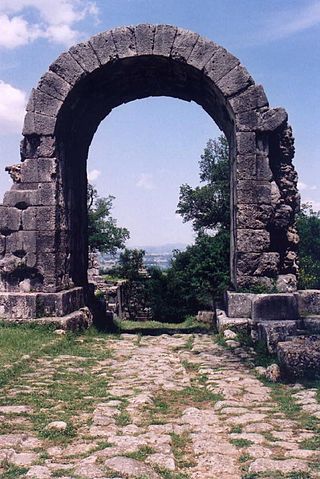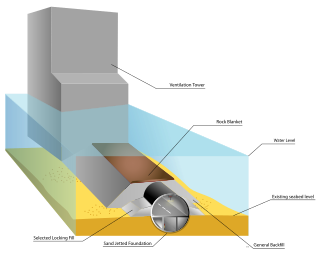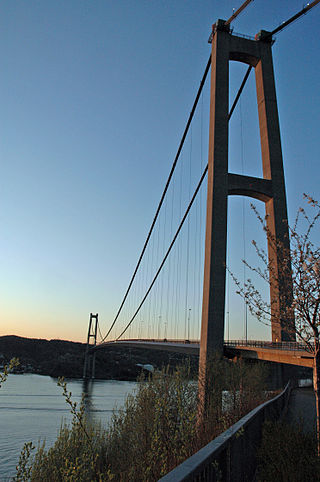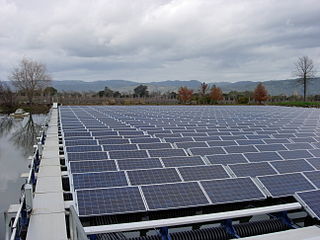
The Øresund or Öresund Bridge is a combined railway and motorway bridge across the Øresund strait between Denmark and Sweden. It is the longest in Europe with both roadway and railway combined in a single structure, running nearly 8 kilometres from the Swedish coast to the artificial island Peberholm in the middle of the strait. The crossing is completed by the 4-kilometre (2.5 mi) Drogden Tunnel from Peberholm to the Danish island of Amager.

The Via Flaminia or Flaminian Way was an ancient Roman road leading from Rome over the Apennine Mountains to Ariminum (Rimini) on the coast of the Adriatic Sea, and due to the ruggedness of the mountains was the major option the Romans had for travel between Etruria, Latium, Campania, and the Po Valley. The section running through northern Rome is where Constantine the Great had his famous vision of the Chi Rho, leading to his conversion to Christianity and the Christianization of the Roman Empire.

The Rialto Bridge is the oldest of the four bridges spanning the Grand Canal in Venice, Italy. Connecting the sestieri (districts) of San Marco and San Polo, it has been rebuilt several times since its first construction as a pontoon bridge in 1173, and is now a significant tourist attraction in the city.

The Strait of Messina Bridge is a proposal to build a suspension bridge across the Strait of Messina in Italy to connect the cities of Torre Faro and Villa San Giovanni.

Qiandao Lake, a human-made, freshwater lake located in Chun'an County, Hangzhou, Zhejiang Province, China, was formed after the completion of the Xin'an River hydroelectric station in 1959.

An immersed tube is a kind of undersea tunnel composed of segments, constructed elsewhere and floated to the tunnel site to be sunk into place and then linked together. They are commonly used for road and rail crossings of rivers, estuaries and sea channels/harbours. Immersed tubes are often used in conjunction with other forms of tunnel at their end, such as a cut and cover or bored tunnel, which is usually necessary to continue the tunnel from near the water's edge to the entrance (portal) at the land surface.

The Nordhordland Bridge is a combined cable-stayed and pontoon bridge which crosses Salhusfjorden between Klauvaneset and the island of Flatøy in Vestland county, Norway. It is 1,614 meters (5,295 ft) long, of which the pontoon section is 1,246 meters (4,088 ft) long. The cable-stayed section consists of a single 99-meter (325 ft) tall H-pylon which has a length of 368 meters (1,207 ft) and a main span of 172 meters (564 ft). This allows for a clearance of 32 meters (105 ft).

The Askøy Bridge is a suspension bridge that crosses the Byfjorden between the municipalities of Bergen and Askøy in Vestland county, Norway. It is 1,057 meters (3,468 ft) long and has a main span of 850 meters (2,789 ft). Its span was the longest for any suspension bridge in Norway, until the Hardanger Bridge was opened in August 2013. Now the bridge is the third longest in Norway. It carries two lanes of County Road 562 and a combined pedestrian and bicycle path. The bridge's two concrete pylons are 152 meters (499 ft) tall and are located at Brøstadneset in Bergen municipality and Storeklubben in Askøy municipality. The bridge has seven spans in total, although all but the main span are concrete viaducts. The bridge has a clearance below of 62 meters (203 ft).

The Bergsøysund Bridge is a pontoon bridge that crosses the Bergsøysundet strait between the islands of Aspøya and Bergsøya in Møre og Romsdal county, Norway. The bridge is 931 metres (3,054 ft) long, the longest span is 106 metres (348 ft), and the maximum clearance to the sea is 6 metres (20 ft). The bridge has 13 spans.

The Strait of Gibraltar crossing is a hypothetical bridge or tunnel spanning the Strait of Gibraltar that would connect Europe and Africa. The governments of Spain and Morocco appointed a joint committee to investigate the feasibility of linking the two continents in 1979, which resulted in the much broader Euromed Transport project.

Riccardo Morandi was an Italian civil engineer best known for his innovative use of reinforced concrete and prestressed concrete, although over the years some of his particular cable-stayed bridges have had some maintenance trouble.
An underwater tunnel is a tunnel which is partly or wholly constructed under the sea or a river. They are often used where building a bridge or operating a ferry link is unviable, or to provide competition or relief for existing bridges or ferry links. While short tunnels are often road tunnels which may admit motorized traffic, unmotorized traffic or both, concerns with ventilation lead to the longest tunnels being electrified rail tunnels.
A fixed link or fixed crossing is a permanent, unbroken road or rail connection across water that uses some combination of bridges, tunnels, and causeways and does not involve intermittent connections such as drawbridges or ferries. A bridge–tunnel combination is commonly used for major fixed links.

The Ponte della Costituzione is the fourth bridge over the Grand Canal in Venice, Italy. It was designed by Santiago Calatrava, and was moved into place in 2007, amid protest by politicians and the general public. The bridge was installed in 2008 and opened to the public on the night of September 11, 2008. The bridge was known as Quarto Ponte sul Canal Grande before the official name was adopted to celebrate the 60th anniversary of the Italian constitution in 2008. Tourists and locals in Venice now refer to it as the Calatrava Bridge.

The Tromsøysund Tunnel is an undersea highway tunnel in Tromsø Municipality in Troms og Finnmark county, Norway. The tunnel runs under the Tromsøysundet strait, connecting the island of Tromsøya with the mainland suburb of Tromsdalen.

The Knappe Tunnel is a four-lane, twin-tube motorway tunnel in the city-municipality of Bergen in Vestland county, Norway. The tunnel is part of County Road 557 and consists of the first and second stages of the four-lane motorway project called Ring Road West. The southern part of the tunnel goes under the Nordåsstraumen, a small strait connecting the lake Nordåsvatnet and the Grimstadfjorden.

The Melide causeway crosses across Lake Lugano in the Swiss canton of Ticino, connecting the communities of Melide and Bissone, and provides the only domestic land connection between the southern section of Ticino, around Mendrisio and Chiasso, and the rest of Switzerland.

Floating solar or floating photovoltaics (FPV), sometimes called floatovoltaics, are solar panels mounted on a structure that floats on a body of water, typically a reservoir or a lake such as drinking water reservoirs, quarry lakes, irrigation canals or remediation and tailing ponds. A small number of such systems exist in China,France, India, Japan, South Korea, the United Kingdom, Singapore, and the United States.

The Stretto di Messina S.p.A. company was established in 1981 in implementation of law no. 1158/1971 of the Italian government to design, build and manage the Strait of Messina Bridge.



















